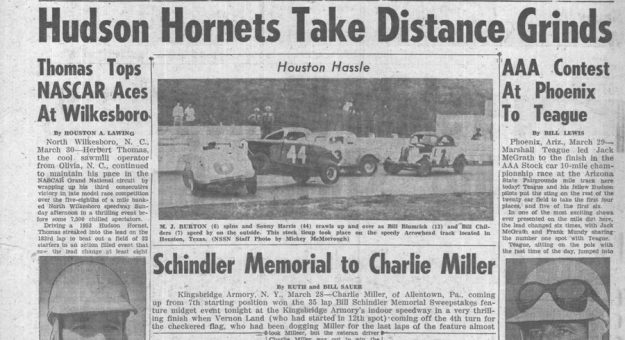As American automobile manufacturers paid greater attention to NASCAR Grand National division competition between their strictly stock cars, NSSN began reporting the score.
During the 1951 season, drivers with Oldsmobiles posted 21 victories and 64 top-five finishes over the course of the season reflected the brand’s popularity both on the street and on the track. More drivers raced with Oldsmobiles than any other make during the first four years of NASCAR.
Another popular manufacturer was Plymouth, which scored 45 top-five finishes in 1951. Ford, Studebaker, Mercury and Pontiac also fared well on the racing ovals. This success, manufacturers realized, increased sales to a car-crazed public becoming infatuated with auto racing.
Much of the public’s adoration went to Marshall Teague’s Hudson Hornet — also known as the Fabulous Hudson Hornet thanks to Teague christening his Hornet with this moniker, which finished third in manufacturer totals with 31 top-five placings in its first year on the Grand National circuit in 1951.
The Hornet’s early impact on NASCAR grew to domination for the next two years as Hornet drivers attained 83 top-fives in 1952 and 85 in ’53. This success came in part because of the great number of Hudsons starting NASCAR-sanctioned races: 288 in 1952 and 282 in ’53 — more than any other make of car.
The Best Drivers On The Circuit
Some of the best drivers on the circuit raced in Hornets. Reigning Grand National champion Tim Flock and his older brother Fonty, California-born Dick Rathmann and 1951 champ Herb Thomas all piloted the nameplate to victory lane in 1953.
Thomas drove his Hudson Hornet to NASCAR’s top spot. Commencing with his victory in Spring Lake (N.C.) in March, the North Carolina sawmill operator jetted to 12 triumphs and the largest championship points margin of victory in NASCAR history: 8,400 to 7,814 over Lee Petty. The two-time champ was so dominant he led all drivers in poles (11), victories (12), money won (a record $28,910), laps led (1420) and races led (23).
Thomas drove his No. 92 in all 37 Grand National events, including the Raleigh 300 at the Bill France-operated Raleigh (N.C.) Speedway. This paved, one-mile oval cost $500,000 to construct and featured 55-foot-wide straightaways and 78-foot-wide high banks which Fonty Flock used to pass the 42 cars which started ahead of him for one of his four victories that season.
The season was not as successful for defending champion Tim Flock. He finished sixth in the points race, but started only 26 of the 37events due in large part to what the Aug. 26 issue of NSSN quoted him as saying was “the closest call I’ve ever had even counting the spills on the tracks.” While napping on the ground before the July 4 race in Spartanburg, S.C., a car backed into Flock’s head.
Because of this injury, he missed the next seven features and lost valuable opportunities to defend his title. Despite this near-tragedy, Flock won five poles and triumphed at Hickory (N.C.) Motor Speedway.
In the other divisions, change was the theme as new champions reigned at the end of the season. Jim Reed gained the short track late model crown and Virginian Joe Weatherly raced to the modified title. In the midget division, Nick Fomoro became the champ. After a three-year run by Mike Klapak, Johnny Roberts stole the sportsman season laurels.
Pushing Westward
NASCAR also experienced a monumental year. The ever-growing sanctioning body journeyed west to in Nebraska, South Dakota and Iowa, among other places, for the first time as Bill France pushed westward.
Another major sponsor signed with NASCAR in November, when the Pure Oil Co. agreed to sponsor Speedweek at Daytona Beach. The biggest news of all, however, became the early negotiations between NASCAR and Daytona Beach (Fla.) officials regarding the proposed 2.5-mile superspeedway Bill France envisioned.
The Dec. 16 issue of NSSN reported, “The track, according to engineers, would stand up under speeds of up to 200 mph.”
Editor’s Note: NASCAR is celebrating its 75th anniversary in 2023. SPEED SPORT was founded in 1934 and was already on its way to becoming America’s Motorsports Authority when NASCAR was formed. As a result, we will bring you chapter 6 of a 75-part series on the history of NASCAR as told in the pages of National Speed Sport News and SPEED SPORT Magazine.
